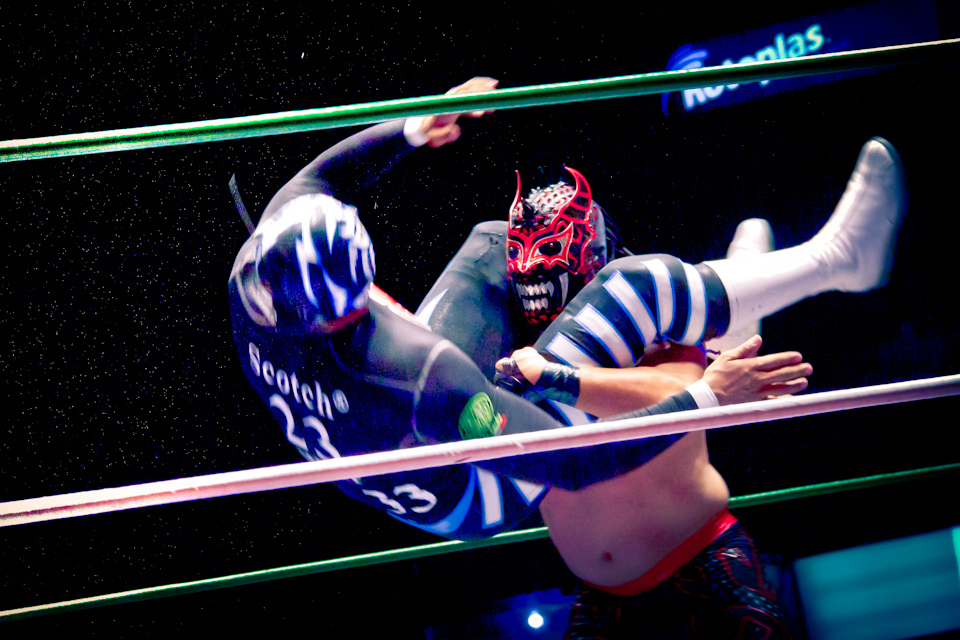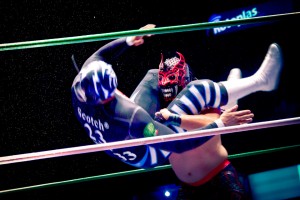I think I may have surprised (and frightened) my girlfriend over the weekend with the vast knowledge I have about professional wrestling.
After almost six years living in Mexico and a little over a year in Mexico City, last Saturday was my first experience with those masked superheros who call themselves luchadores. But I had Randy Macho Man Savage, Hulk Hogan and The Rock as points of reference. That’s what happens when your brother is five years older and controls the remote. We used to watch WWF religiously every week and if you would have asked me any time between age 7 and 13, I could have told you all the story lines, all the rivalries and all the past injuries. That’s why explaining what a tag team is and how to tell the good guys from the bad guys came so easy to me – much to the embarrassment and wonder of the person I live with and who thinks she knows me pretty well.
Lucha Libre is a little different from what I’m used to. I get it that the masks are a way to fake out your opponent and a sign of pride but they made me feel like the luchadores were more anonymous and interchangeable – I mean really, if Mistico gets injured or offered some really lucrative gig as an underwear model, they can just find some other buff, young dude to take his place – nobody knows what his face looks like. There’s also no talking, which means no backstage threats, no self-aggrandizing and no catcalls. Don’t get me wrong, the luchadores work the crowd but I wasn’t sure if I could ever get as personally attached to them as I was to Mick Foley.
 Lucha Libre is not a cheap import from the United States but has a long and beloved history in here in Mexico. It’s not totally clear in Lucha Libre lore who originally brought free-style fighting to Mexico, but one thing everyone agrees on is that Salvador Lutteroth Gonzalez made it famous. Lutteroth, a Spanish boxing promoter, started his own promotion company called Empresa Mexicana de Lucha Libre in the 1930s. He brought fighters from all over the world to Mexico to win over the crowds but it wasn’t until the Spanish civil war in 1936 (when many wrestlers, trainers, and promoters moved to Mexico) and then the onset of TV in the 1940s that really gave the sport it’s boost.
Lucha Libre is not a cheap import from the United States but has a long and beloved history in here in Mexico. It’s not totally clear in Lucha Libre lore who originally brought free-style fighting to Mexico, but one thing everyone agrees on is that Salvador Lutteroth Gonzalez made it famous. Lutteroth, a Spanish boxing promoter, started his own promotion company called Empresa Mexicana de Lucha Libre in the 1930s. He brought fighters from all over the world to Mexico to win over the crowds but it wasn’t until the Spanish civil war in 1936 (when many wrestlers, trainers, and promoters moved to Mexico) and then the onset of TV in the 1940s that really gave the sport it’s boost.
That and the famous “El Santo” – probably Mexico’s most beloved luchador, who won hearts and minds with his triumph in an 8-man battle royal in 1942 in Mexico City and subsequently went on to star in all kinds of weird movies. (Check out this incredible British TV show from the 80s and their tribute to him. The best part is at the very beginning when the interviewee says “Very few things become folklore in Mexico but El Santo is one of them” — Very few things?!)
Where I sat on Saturday in the Arena Mexico in the neighborhood of Los Doctores was once the home of the Arena Modelo, a 5,000-seater that was Lutteroth’s last choice for Lucha Libre’s debut in Mexico City (he couldn’t get anywhere else to agree to host them) but eventually became a kind of mecca for Lucha Libre fans across the country.
At two and a half hours long I wasn’t sure I’d make it to the end of the show and there were moments — halfway through my giant, six-dollar beer — that I could feel my mind wandering. But the spectacular acrobatics of those guys — one of their claims to fame — kept me awake. And after all the show and stuntsmanship, I had to admit it — I love their masks and I hope they keep wearing them.
Click here to subscribe via RSS


it was a bit scary, carey!